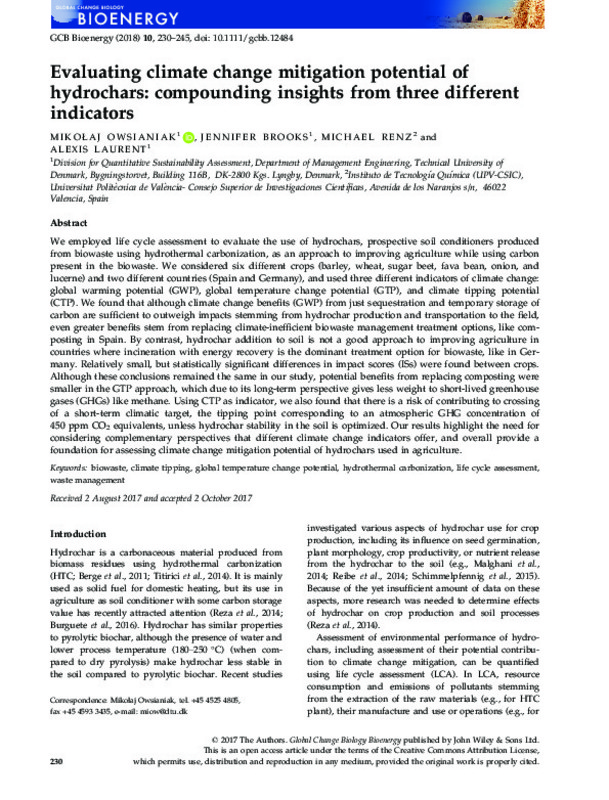JavaScript is disabled for your browser. Some features of this site may not work without it.
Buscar en RiuNet
Listar
Mi cuenta
Estadísticas
Ayuda RiuNet
Admin. UPV
Evaluating climate change mitigation potential of hydrochars: compounding insights from three different indicators
Mostrar el registro sencillo del ítem
Ficheros en el ítem
| dc.contributor.author | Owsianiak, Mikolaj
|
es_ES |
| dc.contributor.author | Brooks, Jennifer
|
es_ES |
| dc.contributor.author | Renz, Michael
|
es_ES |
| dc.contributor.author | Laurent, Alexis
|
es_ES |
| dc.date.accessioned | 2019-07-03T20:02:23Z | |
| dc.date.available | 2019-07-03T20:02:23Z | |
| dc.date.issued | 2018 | es_ES |
| dc.identifier.issn | 1757-1693 | es_ES |
| dc.identifier.uri | http://hdl.handle.net/10251/123139 | |
| dc.description.abstract | [EN] We employed life cycle assessment to evaluate the use of hydrochars, prospective soil conditioners produced from biowaste using hydrothermal carbonization, as an approach to improving agriculture while using carbon present in the biowaste. We considered six different crops (barley, wheat, sugar beet, fava bean, onion, and lucerne) and two different countries (Spain and Germany), and used three different indicators of climate change: global warming potential (GWP), global temperature change potential (GTP), and climate tipping potential (CTP). We found that although climate change benefits (GWP) from just sequestration and temporary storage of carbon are sufficient to outweigh impacts stemming from hydrochar production and transportation to the field, even greater benefits stem from replacing climate-inefficient biowaste management treatment options, like composting in Spain. By contrast, hydrochar addition to soil is not a good approach to improving agriculture in countries where incineration with energy recovery is the dominant treatment option for biowaste, like in Germany. Relatively small, but statistically significant differences in impact scores (ISs) were found between crops. Although these conclusions remained the same in our study, potential benefits from replacing composting were smaller in the GTP approach, which due to its long-term perspective gives less weight to short-lived greenhouse gases (GHGs) like methane. Using CTP as indicator, we also found that there is a risk of contributing to crossing of a short-term climatic target, the tipping point corresponding to an atmospheric GHG concentration of 450 ppm CO2 equivalents, unless hydrochar stability in the soil is optimized. Our results highlight the need for considering complementary perspectives that different climate change indicators offer, and overall provide a foundation for assessing climate change mitigation potential of hydrochars used in agriculture. | es_ES |
| dc.description.sponsorship | M.O. and M.R. acknowledge the financial support of the European Commission under the Climate-KIC program; CHARM. A.L. and M.O. acknowledge financial support of European Commission under the seventh framework program; SME-2013-2: NEWAPP, grant agreement 605178. | es_ES |
| dc.language | Inglés | es_ES |
| dc.publisher | Wiley-Blackwell Publishing Ltd. | es_ES |
| dc.relation.ispartof | GCB Bioenergy | es_ES |
| dc.rights | Reconocimiento (by) | es_ES |
| dc.subject | Biowaste | es_ES |
| dc.subject | Climate tipping | es_ES |
| dc.subject | Global temperature change potential | es_ES |
| dc.subject | Hydrothermal carbonization | es_ES |
| dc.subject | Life cycle assessment | es_ES |
| dc.subject | Waste management | es_ES |
| dc.subject.classification | QUIMICA INORGANICA | es_ES |
| dc.title | Evaluating climate change mitigation potential of hydrochars: compounding insights from three different indicators | es_ES |
| dc.type | Artículo | es_ES |
| dc.identifier.doi | 10.1111/gcbb.12484 | es_ES |
| dc.relation.projectID | info:eu-repo/grantAgreement/EC/FP7/605178/EU/New technological applications for wet biomass waste stream products/ | es_ES |
| dc.rights.accessRights | Abierto | es_ES |
| dc.description.bibliographicCitation | Owsianiak, M.; Brooks, J.; Renz, M.; Laurent, A. (2018). Evaluating climate change mitigation potential of hydrochars: compounding insights from three different indicators. GCB Bioenergy. 10(4):230-245. https://doi.org/10.1111/gcbb.12484 | es_ES |
| dc.description.accrualMethod | S | es_ES |
| dc.relation.publisherversion | http://doi.org/10.1111/gcbb.12484 | es_ES |
| dc.description.upvformatpinicio | 230 | es_ES |
| dc.description.upvformatpfin | 245 | es_ES |
| dc.type.version | info:eu-repo/semantics/publishedVersion | es_ES |
| dc.description.volume | 10 | es_ES |
| dc.description.issue | 4 | es_ES |
| dc.relation.pasarela | S\367068 | es_ES |
| dc.contributor.funder | European Commission | es_ES |








